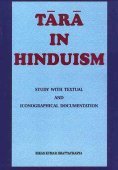Paravati, Pārāvatī, Paravāti, Paṟavāti: 5 definitions
Introduction:
Paravati means something in Buddhism, Pali, Hinduism, Sanskrit, biology, Tamil. If you want to know the exact meaning, history, etymology or English translation of this term then check out the descriptions on this page. Add your comment or reference to a book if you want to contribute to this summary article.
In Buddhism
Tibetan Buddhism (Vajrayana or tantric Buddhism)
Source: academia.edu: The Structure and Meanings of the Heruka MaṇḍalaPārāvatī (पारावती) is the name of a Ḍākinī who, together with the Vīra (hero) named Pārāvata forms one of the 36 pairs situated in the Vāyucakra, according to the 10th century Ḍākārṇava chapter 15. Accordingly, the vāyucakra refers to one of the three divisions of the dharma-puṭa (‘dharma layer’), situated in the Herukamaṇḍala. The 36 pairs of Ḍākinīs [viz., Pārāvatī] and Vīras are dark blue in color; they each have one face and four arms; they hold a skull bowl, a skull staff, a small drum, and a knife.

Tibetan Buddhism includes schools such as Nyingma, Kadampa, Kagyu and Gelug. Their primary canon of literature is divided in two broad categories: The Kangyur, which consists of Buddha’s words, and the Tengyur, which includes commentaries from various sources. Esotericism and tantra techniques (vajrayāna) are collected indepently.
Biology (plants and animals)
Source: Google Books: CRC World Dictionary (Regional names)Paravati in India is the name of a plant defined with Ananas comosus in various botanical sources. This page contains potential references in Ayurveda, modern medicine, and other folk traditions or local practices It has the synonym Bromelia communis Lam. (among others).
Example references for further research on medicinal uses or toxicity (see latin names for full list):
· Fieldiana, Botany (1958)
· Anales Ci. Parag. (1919)
· Mém. Soc. Linn. Paris (1825)
· Species Plantarum (1753)
· Systema Vegetabilium
· Edwards's Botanical Register, or Flower Garden and Shrubbery (1968)
If you are looking for specific details regarding Paravati, for example chemical composition, side effects, diet and recipes, extract dosage, health benefits, pregnancy safety, have a look at these references.

This sections includes definitions from the five kingdoms of living things: Animals, Plants, Fungi, Protists and Monera. It will include both the official binomial nomenclature (scientific names usually in Latin) as well as regional spellings and variants.
Languages of India and abroad
Sanskrit dictionary
Source: Cologne Digital Sanskrit Dictionaries: Monier-Williams Sanskrit-English Dictionary1) Pārāvatī (पारावती):—[from pārāvata] f. the fruit of the Averrhoa Acida, [cf. Lexicographers, esp. such as amarasiṃha, halāyudha, hemacandra, etc.]
2) [v.s. ...] a form of song peculiar to cowherds, [cf. Lexicographers, esp. such as amarasiṃha, halāyudha, hemacandra, etc.]
3) [v.s. ...] Name of a river, [cf. Lexicographers, esp. such as amarasiṃha, halāyudha, hemacandra, etc.]
4) Pārāvati (पारावति):—[from pārāvata] m. [patronymic] of Vasu-rocis, [cf. Lexicographers, esp. such as amarasiṃha, halāyudha, hemacandra, etc.]
5) [v.s. ...]
[Sanskrit to German]
Sanskrit, also spelled संस्कृतम् (saṃskṛtam), is an ancient language of India commonly seen as the grandmother of the Indo-European language family (even English!). Closely allied with Prakrit and Pali, Sanskrit is more exhaustive in both grammar and terms and has the most extensive collection of literature in the world, greatly surpassing its sister-languages Greek and Latin.
See also (Relevant definitions)
Starts with: Paravati-padi, Paravaticcampa.
Ends with: Tikamparavati.
Full-text: Paravati-padi, Paravata, Dove, Vayucakra.
Relevant text
Search found 4 books and stories containing Paravati, Pārāvatī, Paravāti, Paṟavāti, Pārāvati, Para-vāti, Para-vati; (plurals include: Paravatis, Pārāvatīs, Paravātis, Paṟavātis, Pārāvatis, vātis, vatis). You can also click to the full overview containing English textual excerpts. Below are direct links for the most relevant articles:
Rig Veda (translation and commentary) (by H. H. Wilson)
Rig Veda 5.73.1 < [Sukta 73]
Bhakti-rasamrta-sindhu (by Śrīla Rūpa Gosvāmī)
Verse 2.1.88 < [Part 1 - Ecstatic Excitants (vibhāva)]
Diaspora of Bhuta (Daiva) worshipping cult—India and Indonesia (by Shilpa V. Sonawane)
Part 3.1 - Hindu Gods and Goddesses of Bali < [Chapter 4 - Inter-Disciplinary Analysis]
Part 3 - Religion and Culture of Bali (Introduction) < [Chapter 4 - Inter-Disciplinary Analysis]
Jivanandana of Anandaraya Makhin (Study) (by G. D. Jayalakshmi)
Analysis of Jñāna Śarmā (Apavarga-sādhaka-mantrī) < [Chapter 6 - Dramatic aspects of the Jīvanandana Nāṭaka]
Related products
